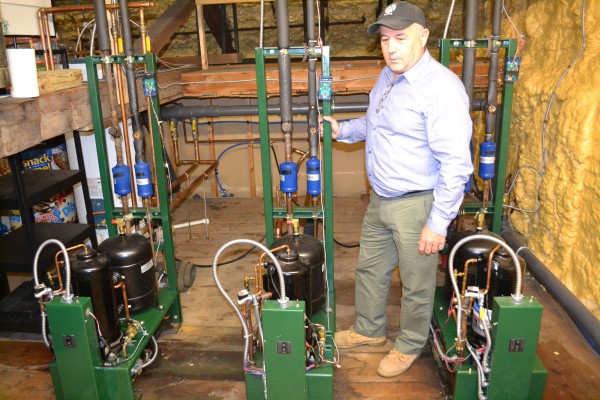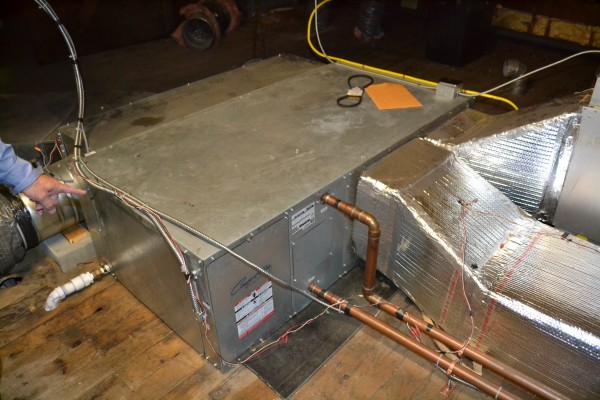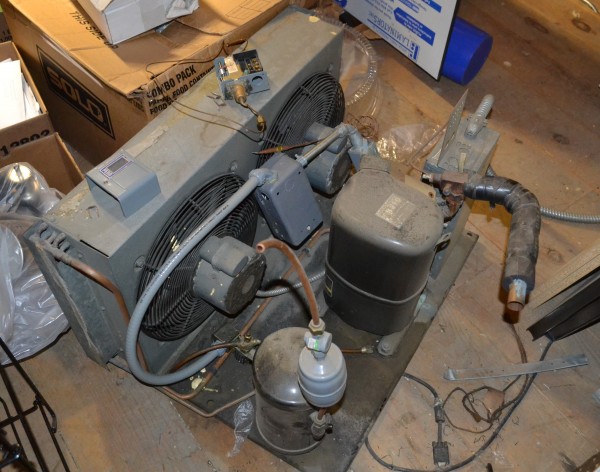
FARMINGTON – For Jim LaBrecque, it’s a matter of efficiency.
A former resident of Jay and graduate of Mt. Blue High School, LeBrecque previously operated Jim’s Refrigeration, installing cooling, heating and ventilation systems in grocery stores such as Don’s AG and Giguere’s. Now he works with retired professor Richard Hill of Orono to create custom-designed refrigeration and heating systems for businesses ranging from Trump Tower in New York City to the state’s Blaine House in Augusta to Tranten’s on Main Street in downtown Farmington. He also sits of the governor’s energy advisory committee, a group of 10 experts from a variety of energy-related fields.
“Normally, you’d have a dozen compressors, more outside, and a big furnace,” LaBrecque said, ducking under rafters in the cavernous attic that sits above the store. Instead, “We have three little units, humming away 24 hours a day, that provide all the refrigeration and heat for the building.”
The trio of compressors, tanks perched on steel frames that feed hot, cold and lukewarm copper pipes, were constructed by LaBrecque and electrician Gary Swett. They run into a great hoop of liquid that transfers heat energy from the store’s coolers to the compressors and from the compressors to the heat pump, an aluminum box located at the other end of the attic. The pump draws the heat from the liquid conduit and pipes it into the store.

Approximately five days a year, the pump needs to be augmented with a small, gas-powered heater; otherwise, there’s no other heat source for the store. According to LaBrecque, that saves Tranten’s in Farmington an estimated $42,000 annually. The Kingfield store saves twice as much.
Three hundred days a year, he said, they’re throwing heat away. The system produces enough heat to warm the surrounding buildings.
Among heating systems available to Mainers, LaBrecque said, heat pumps have a unique property of providing three units of heat energy per single unit of expended energy. LaBrecque contrasts that level of efficiency with an electric heater, which takes in a single unit of electricity and utilizes it to produce a single unit of heat.
If a homeowner utilizes an oil furnace burning roughly 800 gallons a year, LaBrecque said, a $3,000 heat pump could cut that usage down to 200 gallons, or less. Currently, he noted, 434,000 homes in Maine heat with oil.
With those numbers in mind, Gov. Paul LePage directed the energy advisory group to come up with options that would cut down the amount of heating oil used by Mainers, have fast payback and wouldn’t require the use of federal subsidies. The group, which includes professors associated with the UMaine system, industry engineers and employees of institutions ranging from power generation to manufacturing, turned to heat pumps. After that, they set about trying to find the correct pump size to subsidize: too small and the impact on oil usage is lost, too big and the payback increases beyond the governor’s parameters.
After legislation modified the Efficiency Maine program to include heat pump rebates, demand for the units have expanded to strain the existing number of installers. Eastern Maine Community College is now writing training programs for would-be installers, as heating companies begin offering installation services.
Since July 2013, roughly 1,500 homeowners have installed heat pump water heaters using Efficiency Maine rebates, up from 281 the year before, according to the organization.
LaBrecque prefers heat pumps to small wind power generators and solar collectors, both of which he believes don’t provide enough power generation to warrant their installation costs. A small wind turbine might produce 800 to 900 kilowatts a year, enough to run a 100-watt light bulb. Thanks to inactivity due to fog and rain and the obvious nighttime hours, solar collectors had roughly a 14 percent activity rate according to their own manufacturers, LaBrecque said. Three, 255-watt solar collectors would light the same 100-watt bulb.
LaBrecque recalled the early lessons from his work in supermarket systems. “It didn’t take me too long to figure out that solar collectors and small wind had nothing to bring to the table when it came to running commercial machinery,” he said. “They aren’t the most successful in terms of bang for the buck.”
The biggest advantage heat pumps had over other homeowner-accessible improvements was the general inefficiency of heating systems. Mainers use five times the energy to heat their homes as they do to electrify them, LaBrecque said, and moving heat was much more efficient than creating it.
“It’s not magic,” LaBrecque said. “It’s just simple.”
Efficiency Maine provides up to $300 in incentives for heat pump water heater installations, with a separate program for commercial businesses. More information about Efficiency Maine can be found here.









We installed a heat pump hot water tank, in place of hot water from our boiler a little over a year ago.
It has worked as promised, adding a little to our electric bill each month, but more than making up for it by letting us shut down the boiler from the warm side of spring to the cold side of fall. We believe it will have paid for itself in three years. or a little less, depending on the price for oil. As compared to replacing a traditional electric hot water tank, it would still pay for itself in about three years.
A side benefit of the hot water heat pump, if installed in your basement, is that it reduces the amount you have to run a dehumidifier.
We got our GE Geospring hot water tank locally from CJ’s appliance, and had ABT install it, and were able to get the rebate from Efficiency Maine. CJ’s did the paperwork for the rebate, and the check came to us.
Retired professor Dick Hill of Orono, approaching 96 years old, considers Jim LaBrecque as one of the most gifted electrical engineers in the Northeast. LaBrecque is an inventor of the greatest kind….designing, engineering, and building advanced energy efficient refrigeration systems is his gift to humanity. He is the most humble and selfless person I have ever known. I consider myself one of the luckiest guys I know just to have had the opportunity to watch him continually upgrade and redefine the state-of-the art in refrigeration and heating technology over the last several decades.
Ben Hanstein’s article has condensed Jim LaBrecque’s contributions in an excellent fashion and should be submitted for an appropriate award for bringing the role of energy efficient heat pumps and their uses in the Northeast to the Daily Bulldog readership. Bravo for such a fine piece of informative literature.
Great engineering, great article, could be an energy boon worldwide in areas that have cold winters! Congrats to all!
I put my heat pump in mid last winter and have been tracking energy use all year. I will post the results when a year is full but it is on course for a slightly better than 2 year payback
only problem with this article is the Efficiency Maine program is funded by RGGI and guess who pays for the RGGI? We the rate payers.
At last, an engineer doing what an engineer is trained to do. Prove the value by the numbers, not by political thinking styled by dreamers, fear mongers and the guilty rich.